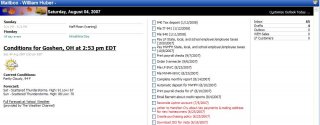I have decided to do some playing around with unit tests for PHP. I saw a video on Getting Involved in WordPress and it reminded me of my interest in unit testing. Now I almost want to create some unit tests for verifying WordPress plugins or phpWebSite code. Fortunately, common sense will prevail and I will restrict my activities to playing. The instructions at Chapter 3. Installing PHPUnit looked pretty easy but since I wanted to do my testing under XAMPP I knew there would be problems. Hopefully the problems would be minor.
Confirm the PEAR configuration
The first thing I did was to open a command window in the PHP directory under xampp and ran the following command.
pear show-config
This command prompting elicited an error about improperly set environment variables. So I edited the file and inserted the full path to the XAMPP directory. I tried the command again and it showed the PEAR configuration. I checked the installed packages and it showed PHPUnit to be version 1.3.2. I would like to use the latest version so I am going to follow the instructions from the documentation.
Update the channel and install the PHPUnit
The next commands I tried were to update the channel and install PHPUnit.
pear channel-discover pear.phpunit.de
pear install phpunit/PHPUnit
The channel command worked. The install command did not work since it wanted the a dependency updated, GraphViz. After updating the dependency I ran the install command again. It installed 3.1.7 and it said I could also install pdo_sqlite and xdebug. I tried to install these extensions but they ended with a DSP error.
Test the PHPUnit
To test the installation I created a new folder under htdocs called phpunit so that I would have all of the unit test files in one spot. I quickly found out that I needed a copy of the phpunit.bat file in that directory, too. This file is in the PHP folder and it has the correct path to the php.exe file. I copied the example ArrayTest from the documentation into a file called ArrayTest.php and ran the command, “phpunit ArrayTest“. It worked. Now I can move on to more sophisticated unit tests.
Final Fixups
After a little searching I found that the xdebug and pdo_sqlite extenstions already exist in the extensions folder. XAMPP installs all of the extensions but only enables a couple of them in the default installation. All I had to do was to edit the php.ini file, remove the semi-colon in front of these extensions, and restart the web server.

